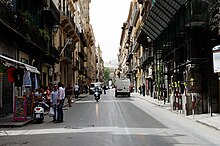Corso Vittorio Emanuele (Palermo)
The Corso Vittorio Emanuele (also Via Vittorio Emanuele called) is a main town Palermo . It is one of the oldest streets in the city.
course
The Corso runs in a southwest-northeast direction and forms the longitudinal axis of the old town. The road starts near the old port of La Cala with the gate Porta Felice . Approximately in the middle of the course, it crosses Via Maqueda at a right angle and divides the old town into the four districts of Kalsa , Albergheria , Capo and Loggia at the architecturally and city-planning significant intersection, the Quattro Canti square . Seen from the harbor, in front of the Quattro Canti, there is the intersection with Via Roma . The street ends with the Porta Nuova at the Norman Palace . From here it continues as Corso Calatafimi to the end of Palermo and the beginning of Monreale .
history
The street was built on the former Arab street Cassaro . This was the main street of the Arab quarter of the same name Cassaro , arab. "Al Quasr" ( the fortress ). It was created around 971 and was located on a peninsula between the former rivers Kemonia and Papireto within the former Punic city wall (Neapolis). This reached up to the height of today's Via Roma , where the sea bordered in Punic times.
After the end of the 15th century began to straighten and fortify the well-trodden paths of the enlarged city within the medieval wall, the Spanish viceroy Garcia di Toledo initiated more drastic interventions in the cityscape in 1567. Initially, the course of the Cassaro was deviated by 6 degrees northwest to the Porta Nuova , which was built in place of the Porta dell'Aquila . To carry out this project, many buildings had to be demolished or architecturally changed.
In addition, the Viceroy ordered an extension of the Cassaro on the northeast side by around 600 m from the height of Via Roma to Piazza Marina . The extension of the street was also named Via Toledo after the client.
In 1581, at the instigation of the viceroy Marcantonio Colonna, the Cassaro was extended by another 400 m to the sea, which had since receded. The deviation of the axis required further structural measures. Here too, buildings had to be changed or demolished. The old gate Porta Patitelli gave way to today's Porta Felice .
The viceroy Marcantonio Colonna arranged for an extension of the traffic artery inland on the southeast side from 1580 to 1585. It began about at the height of the Palazzo Reale on the former Punic city wall to the hinterland and ran to the neighboring town and Benedictine monastery of Monreale .
Because of its route between the two cities, the street was initially called Via Mezzomonreale . It now formed a continuous road connection from the sea to the hinterland. In the 19th century the name Corso Calatafimi became established for the course of the street - after the Battle of Calatafimi , which the guerrilla leader Giuseppe Garibaldi led there in 1860 with his platoon of a thousand .
Via Maqueda , which crosses Corso Vittorio Emanuele in the middle and at right angles , was fortified around 1600. The Quattro Canti square was created from the intersection . The medieval city now had a center, which it divided into four elegant quarters ( quattro parti nobili ).
These building measures corresponded to the emerging tendency of the baroque to design the environment according to geometrical aspects. The highlight of the baroque design was the architectural design of the Quattro Canti square, which, equipped with four baroque palaces and rich sculptures, shapes the image of the intersection to this day.
The street was named Corso Vittorio Emanuele at the end of the 19th century after Victor Emanuel II , the first king of the newly founded Kingdom of Italy in 1861 .
literature
- Giuseppe Bellafiore: Palermo. Guida della città , Palermo 2002.
- Salvo di Matteo: Palermo. Storia della città , edizione Kalós, Palermo 2002, SBN Pal0196574


